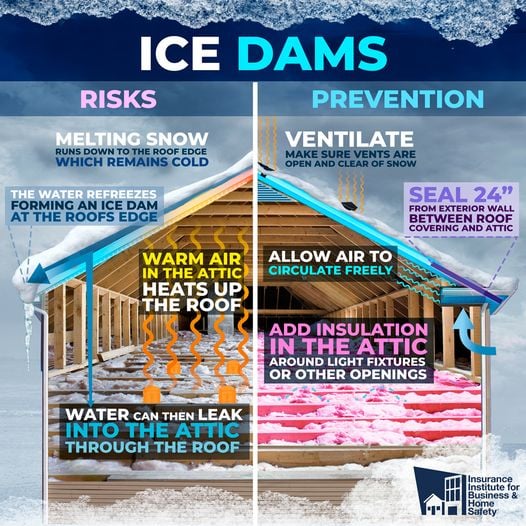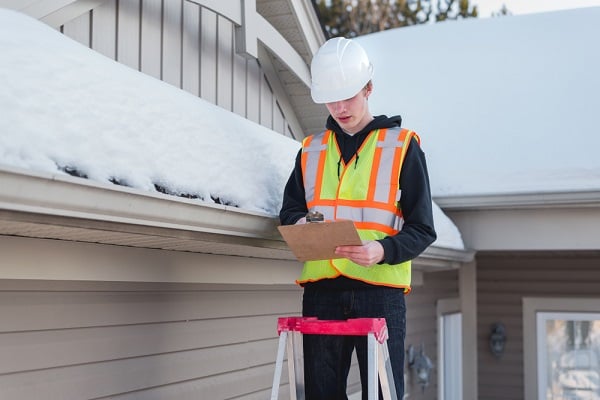What is an Ice Dam and What to Do if You Have One

Icicles are pretty after winter weather, but if you've got them on your home, it may mean trouble. Icicles hanging from your home's gutters can be a telltale sign of ice dams, a potentially damaging buildup of frozen precipitation along your home's roofline. Ice dams form when snow on your roof melts from the warmer air in your attic and then refreezes.

As the ice melts and runs down to unheated areas over the eaves of your roof, it drips and begins to refreeze around your roof's edge or gutters, creating long icicles. This frozen barrier is also slowly backing up any remaining melting precipitation as it grows, sending water under your roof shingles. And that can mean costly damage to your attic and home.
How to Prevent Ice Dams
There are a few things you can do as a homeowner for ice dam prevention. The most important preventative measure you can take is to thoroughly clean your gutters or have them cleaned by a professional at the end of fall and early spring. The Insurance Institute for Business and Home Safety also has a list of great recommendations on ice dam prevention and remedies.

Here are a few more ways to prevent ice dams:
- Make sure that fan exhaust ducts connected to the kitchen, bathroom, and dryer vents all lead outdoors through either the roof or walls, not through the soffit.
- Add more insulation on the attic floor to keep the heat where it belongs. You should adhere to Energy Star insulation recommendations for Virginia's mixed climate.
- Seal around electrical cables and vent pipes with a fire-stop sealant.
- Ventilate your attic's ridges and eaves with a soffit to circulate cold air under the entire roof.
- If you have a whole house attic fan or attic hatch, seal them with weather-stripped caps and aluminum tape.
How to Remove Ice Dams
If you have an ice dam forming along your home's roofline, it's important to take action soon to prevent or limit damage to your home.
WARNING: Removing an ice dam is a slippery, tedious, and very dangerous job best left to a certified roofer or gutter specialist in your area, especially if you're unable to access your roof without a ladder. They have specialized steaming equipment to safely and quickly remove ice dams and the experience to fix extenuating issues.
If water is actively leaking into your attic or home, the first thing you can try while you're waiting for a professional is to use a fan in your attic pointed at the outside area that is frozen and leaking in. Targeting cool air in the area should quickly stop the leak.
If you're able to easily and safely reach your roof, you can take these steps to help remove the ice dam from your roof and gutters:
-
Pull the snow behind the ice dam off the roof using an aluminum roof rake, ideally removing three to four feet of snow behind the ice. Other tools can damage shingles.
-
Next, apply calcium chloride as a melting product. Note that this chemical can damage plants if exposed in large amounts. It helps to fill a pantyhose with the chemical and lay it onto the roof so it has contact with the ice dam. There are also environmentally friendly heating cables made specifically for the melting needed along your roofline.
-
Be patient! Avoid using any sharp, hard metal tools or chipping away at the ice and icicles. It may seem like a faster solution, but it's bound to damage your roofing, soffit, and parts of your gutter system.
-
It may take some time, but once you are able to see your gutters, make sure they are free of debris and able to carry melting precipitation down your gutter spouts and away from your home's foundation.
Even after successfully removing ice dams, it's important to have your roof and gutters professionally inspected to check for hidden damage. You also need to determine why the ice dam formed in the first place. If your gutters are clear, it may be as simple and inexpensive as adding insulation or identifying unwanted heat sources in your attic. This is another good reason to just hire a roofing specialist to address ice dam prevention. You'll have peace of mind that the problem is fixed and won't happen again.

Is damage from ice dams covered by home insurance?
Yes, if an ice dam causes water damage to your home, that damage can be covered by your home insurance. However, damage from ice dams due to neglect of home maintenance, or damage that occurs over time from a lack of maintenance, may not be covered. Likewise, home insurance does not cover the cost to remove the ice dam as this is considered preventative maintenance.
We hope you don't experience ice dams this winter, but if you do, remember it's important to address it quickly. And if you have a claim, give us a call! We're here to help get your home repaired and protected for the next big snow.
Learn more about homeowners insurance in Virginia >
Sources:
https://ibhs.org/ibhs-news-releases/ice-dams-prevent-them-and-your-roof-will-thank-you/
THE NORTHERN NECK INSURANCE INTEGRITY PROMISE — We pledge to provide straight talk and good counsel from our NNINS Virginia insurance experts through our blog. While we hope you find this to be a helpful source of information, it does not replace the guidance of a licensed insurance professional, nor does it modify the terms of your Northern Neck Insurance policy in any way. All insurance products are governed by the terms in the applicable insurance policy.





